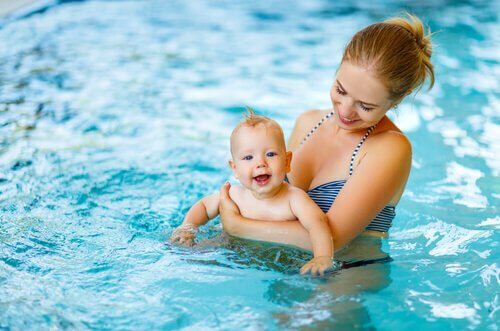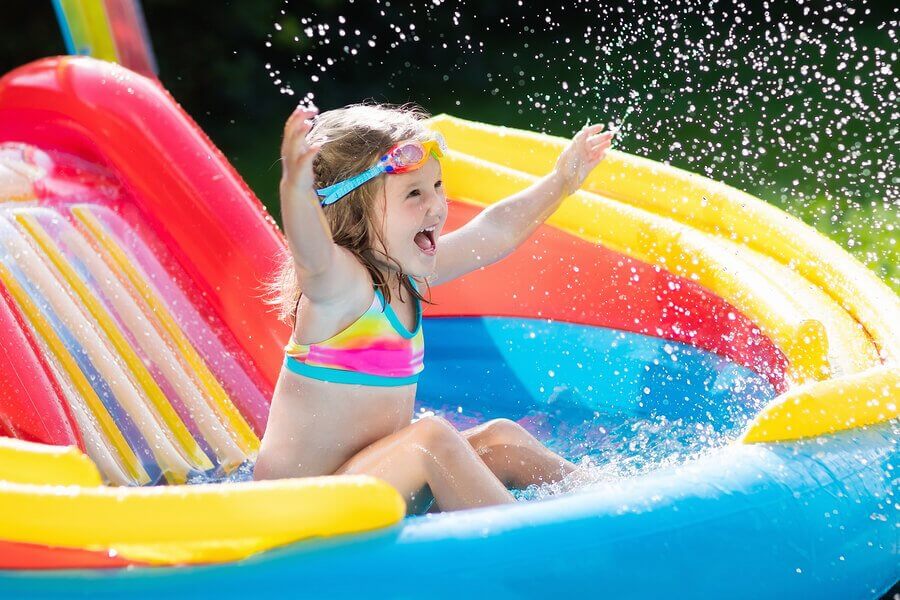The Fear of Water in Children: What You Should Know

The fear of water is relatively common among young children and toddlers. This can persist throughout childhood if not addressed in time, so it’s advisable to confront it as soon as possible
Many young children are frightened by the idea of swimming, or more specifically, sinking. It’s advisable to expose children to water from four or five months of age, as this will give them a sense of familiarity and safety.
Why do children fear water?
The fear of water in children is often triggered by a traumatic past experience. The most typical case is feeling water rise to their nose or noticing that they can’t breathe with water on their face.
We must be vigilant and observe if children seem to be afraid of water in everyday life. The reaction of rejecting water can also be confused with or linked to fear of crowds. Pools and beaches tend to be crowded places – it’s possible that what frightens them is the fear of people rather than water.
A child who is a little anxious about water may also become more disturbed by larger and more intimidating children playing around. Parents, in these cases, must know how to interpret their child’s feelings.
Ideas to alleviate the fear of water in children
The following suggestions can be very helpful for parents dealing with this problem. Of course, in addition to applying them, tolerance and patience are essential.
- Children should have a healthy respect for water: one of the most dangerous things in their environment. Children should always have the necessary caution, while adults should never stop monitoring them.
- Don’t pressure children to enter the water: it’s advisable to allow them to look around and see the other children having fun. This period of observation will allow you to face the situation with greater security.

- Take time to build up their courage. Often, parents make things worse by pressuring children into the water immediately. This can increase their level of anxiety, even before they begin to interact in the water.
- Help gain control over what they do. It’s best to choose a quiet place, away from other children. It’s also very positive to establish basic rules and guidelines on how to play and swim. This can give children the peace of mind they need to enter.
- Use plugs for the nose and ears. Fears about water often arise because children hate the sensation of water running up their noses. Goggles can also relieve anxiety.
“In cases of fear of water in children, tolerance and patience are essential”
How to help children overcome their fear of water?
In addition to the tips above, here are some useful measures to help your little ones overcome this fear:
- We must reward children in their gradual process of approaching the water. Positive reinforcement is one of the best strategies. Although it may take some time, children may eventually end up associating this positivity with being in the water.
- Try fun games that encourage holding your breath. These exercises will allow children to have more and more confidence.

- To overcome the fear of water, we can try this exercise: Take your child to the water and ask him to put his face on the surface. Then, go down a little more, and so on. The little one will see for himself that there is nothing below that can frighten him, with the addition of eliminating the fear of being submerged.
- Use any existing resources so that your child feels safe in the water. There are many products that increase comfort, such as water wings, floats, or life jackets.
- Children feel more comfortable when they notice that water is safe and fun. To do this, incorporate toys that include water, such as toy water or bubble guns, to assure them that they have no reason to fear.
Finally, as one last suggestion, it’s a good idea to provide a children’s pool to play in at home, even if it’s a small, inflatable pool. This way you can play late in the pool with many other little friends. After seeing others have fun, surely the little one who was previously afraid will want to join too.
The fear of water is relatively common among young children and toddlers. This can persist throughout childhood if not addressed in time, so it’s advisable to confront it as soon as possible
Many young children are frightened by the idea of swimming, or more specifically, sinking. It’s advisable to expose children to water from four or five months of age, as this will give them a sense of familiarity and safety.
Why do children fear water?
The fear of water in children is often triggered by a traumatic past experience. The most typical case is feeling water rise to their nose or noticing that they can’t breathe with water on their face.
We must be vigilant and observe if children seem to be afraid of water in everyday life. The reaction of rejecting water can also be confused with or linked to fear of crowds. Pools and beaches tend to be crowded places – it’s possible that what frightens them is the fear of people rather than water.
A child who is a little anxious about water may also become more disturbed by larger and more intimidating children playing around. Parents, in these cases, must know how to interpret their child’s feelings.
Ideas to alleviate the fear of water in children
The following suggestions can be very helpful for parents dealing with this problem. Of course, in addition to applying them, tolerance and patience are essential.
- Children should have a healthy respect for water: one of the most dangerous things in their environment. Children should always have the necessary caution, while adults should never stop monitoring them.
- Don’t pressure children to enter the water: it’s advisable to allow them to look around and see the other children having fun. This period of observation will allow you to face the situation with greater security.

- Take time to build up their courage. Often, parents make things worse by pressuring children into the water immediately. This can increase their level of anxiety, even before they begin to interact in the water.
- Help gain control over what they do. It’s best to choose a quiet place, away from other children. It’s also very positive to establish basic rules and guidelines on how to play and swim. This can give children the peace of mind they need to enter.
- Use plugs for the nose and ears. Fears about water often arise because children hate the sensation of water running up their noses. Goggles can also relieve anxiety.
“In cases of fear of water in children, tolerance and patience are essential”
How to help children overcome their fear of water?
In addition to the tips above, here are some useful measures to help your little ones overcome this fear:
- We must reward children in their gradual process of approaching the water. Positive reinforcement is one of the best strategies. Although it may take some time, children may eventually end up associating this positivity with being in the water.
- Try fun games that encourage holding your breath. These exercises will allow children to have more and more confidence.

- To overcome the fear of water, we can try this exercise: Take your child to the water and ask him to put his face on the surface. Then, go down a little more, and so on. The little one will see for himself that there is nothing below that can frighten him, with the addition of eliminating the fear of being submerged.
- Use any existing resources so that your child feels safe in the water. There are many products that increase comfort, such as water wings, floats, or life jackets.
- Children feel more comfortable when they notice that water is safe and fun. To do this, incorporate toys that include water, such as toy water or bubble guns, to assure them that they have no reason to fear.
Finally, as one last suggestion, it’s a good idea to provide a children’s pool to play in at home, even if it’s a small, inflatable pool. This way you can play late in the pool with many other little friends. After seeing others have fun, surely the little one who was previously afraid will want to join too.
All cited sources were thoroughly reviewed by our team to ensure their quality, reliability, currency, and validity. The bibliography of this article was considered reliable and of academic or scientific accuracy.
- André, C. (2005). Psicologia Del Miedo/The Psychology of the Fear: Temores, Angustias Y Fobias/Fright, Anguish and Phobias. Editorial Kairós.
- del Agua, A. M. P. (1994). La importancia de los tratamientos en la reducción de los miedos y las fobias infantiles. Revista de psicología general y aplicada: Revista de la Federación Española de Asociaciones de Psicología, 47(3), 321-323. https://dialnet.unirioja.es/descarga/articulo/2164704.pdf
- Jones, M. C. (1924). Elimination of children’s fears. Journal of Experimental Psychology, 7, 382-390.
- Zumbrunnen, R., & Fouace, J. (2006). Cómo vencer el miedo al agua y aprender a nadar. Editorial Paidotribo.
This text is provided for informational purposes only and does not replace consultation with a professional. If in doubt, consult your specialist.








